This script will create you a database which let you manage recipes, ingredients, the recip composition (ingredients_recipes) and also unities for you inventory and the composition. It also let you manage your inventory history.
Here is the query to get your current recipe, the ingredients needed, the quantity needed and the stock you currently have :
SELECT recipes.id, recipes.name AS recipeName, ingredients.name AS ingredientNeeded, CONCAT(ingredients_recipes.Qty,' ',neededUnities.name) AS neededQuantity, CONCAT(inventories.qty,' ',inventoryUnities.name) AS availableQuantity FROM recipes
LEFT JOIN ingredients_recipes ON recipes.id=ingredients_recipes.recipe_id
LEFT JOIN ingredients ON ingredients_recipes.ingredient_id = ingredients.id
LEFT JOIN inventories ON ingredients.id=inventories.ingredient_id
LEFT JOIN unities AS inventoryUnities ON inventories.unity_id=inventoryUnities.id
LEFT JOIN unities AS neededUnities ON ingredients_recipes.unity_id=neededUnities.id
WHERE inventories.`update` = (SELECT MAX(`update`) FROM inventories AS inv WHERE inv.ingredient_id = inventories.ingredient_id);
the database :
-- --------------------------------------------------------
-- Host: 127.0.0.1
-- Server version: 5.5.16 - MySQL Community Server (GPL)
-- Server OS: Win32
-- HeidiSQL version: 7.0.0.4053
-- Date/time: 2012-12-14 16:33:22
-- --------------------------------------------------------
/*!40101 SET @OLD_CHARACTER_SET_CLIENT=@@CHARACTER_SET_CLIENT */;
/*!40101 SET NAMES utf8 */;
/*!40014 SET FOREIGN_KEY_CHECKS=0 */;
-- Dumping database structure for database
DROP DATABASE IF EXISTS `database`;
CREATE DATABASE IF NOT EXISTS `database` /*!40100 DEFAULT CHARACTER SET latin1 */;
USE `database`;
-- Dumping structure for table database.ingredients
DROP TABLE IF EXISTS `ingredients`;
CREATE TABLE IF NOT EXISTS `ingredients` (
`id` int(10) NOT NULL AUTO_INCREMENT,
`name` varchar(250) NOT NULL,
`unity_id` int(11) NOT NULL COMMENT 'for the default unity',
`Created` datetime DEFAULT NULL,
PRIMARY KEY (`id`),
KEY `Unity_id` (`unity_id`)
) ENGINE=InnoDB DEFAULT CHARSET=latin1;
-- Dumping data for table database.ingredients: ~0 rows (approximately)
DELETE FROM `ingredients`;
/*!40000 ALTER TABLE `ingredients` DISABLE KEYS */;
/*!40000 ALTER TABLE `ingredients` ENABLE KEYS */;
-- Dumping structure for table database.ingredients_recipes
DROP TABLE IF EXISTS `ingredients_recipes`;
CREATE TABLE IF NOT EXISTS `ingredients_recipes` (
`id` int(10) NOT NULL AUTO_INCREMENT,
`ingredient_id` int(10) NOT NULL,
`recipe_id` int(10) NOT NULL,
`Qty` float NOT NULL,
`Unity_id` int(10) NOT NULL,
PRIMARY KEY (`id`),
UNIQUE KEY `ingredient_id_recipe_id` (`ingredient_id`,`recipe_id`),
KEY `Unity_id` (`Unity_id`)
) ENGINE=InnoDB DEFAULT CHARSET=latin1;
-- Dumping data for table database.ingredients_recipes: ~0 rows (approximately)
DELETE FROM `ingredients_recipes`;
/*!40000 ALTER TABLE `ingredients_recipes` DISABLE KEYS */;
/*!40000 ALTER TABLE `ingredients_recipes` ENABLE KEYS */;
-- Dumping structure for table database.inventories
DROP TABLE IF EXISTS `inventories`;
CREATE TABLE IF NOT EXISTS `inventories` (
`id` int(10) NOT NULL AUTO_INCREMENT,
`ingredient_id` int(10) NOT NULL COMMENT 'ingredient',
`qty` int(10) NOT NULL COMMENT 'quantity',
`unity_id` int(11) NOT NULL COMMENT 'unity for the ingredient',
`update` datetime NOT NULL COMMENT 'date of the inventory update',
UNIQUE KEY `id` (`id`)
) ENGINE=InnoDB DEFAULT CHARSET=latin1;
-- Dumping data for table database.inventories: ~0 rows (approximately)
DELETE FROM `inventories`;
/*!40000 ALTER TABLE `inventories` DISABLE KEYS */;
/*!40000 ALTER TABLE `inventories` ENABLE KEYS */;
-- Dumping structure for table database.recipes
DROP TABLE IF EXISTS `recipes`;
CREATE TABLE IF NOT EXISTS `recipes` (
`id` int(10) NOT NULL AUTO_INCREMENT,
`name` varchar(250) NOT NULL,
`cooking` longtext NOT NULL,
PRIMARY KEY (`id`),
KEY `name` (`name`)
) ENGINE=InnoDB DEFAULT CHARSET=latin1;
-- Dumping data for table database.recipes: ~0 rows (approximately)
DELETE FROM `recipes`;
/*!40000 ALTER TABLE `recipes` DISABLE KEYS */;
/*!40000 ALTER TABLE `recipes` ENABLE KEYS */;
-- Dumping structure for table database.unities
DROP TABLE IF EXISTS `unities`;
CREATE TABLE IF NOT EXISTS `unities` (
`id` int(10) NOT NULL AUTO_INCREMENT,
`name` varchar(50) NOT NULL,
PRIMARY KEY (`id`),
UNIQUE KEY `name` (`name`)
) ENGINE=InnoDB DEFAULT CHARSET=latin1;
-- Dumping data for table database.unities: ~0 rows (approximately)
DELETE FROM `unities`;
/*!40000 ALTER TABLE `unities` DISABLE KEYS */;
/*!40000 ALTER TABLE `unities` ENABLE KEYS */;
/*!40014 SET FOREIGN_KEY_CHECKS=1 */;
/*!40101 SET CHARACTER_SET_CLIENT=@OLD_CHARACTER_SET_CLIENT */;
